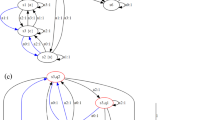Abstract
We consider a method of structural decomposition for an object’s polynomial transition function obtained from an output transition function into a set of structural circuits consisting of standard automation links. The choice of an “optimal” structural circuit is done with the minimal “entropy” criterion.
Similar content being viewed by others
References
Pavlovskii, Yu.N. and Smirnova, T.G., Problema dekompozitsii v matematicheskom modelirovanii (The Decomposition Problem in Mathematical Modeling), Moscow: FAZIS, 1998.
Eliseev, S.N., Decomposing Transition Functions of Multispeed Digital Filters, Radiotekhnika, 2001, no. 11, pp. 77–81.
Kamachkin, A.M. and Shamberov, V.N., The Decomposition Method in Multidimensional Nonlinear Dynamical Systems, Vest. VGU, Ser. Syst. Anal. Inform. Tekhnol., 2012, no. 1, pp. 47–55.
Alpatov, Yu.N. and Drizhenko, A.A., Structural Decomposition with Chain Fractions, Sist. Metody. Tekhnol., 2009, no. 1, pp. 49–52.
Voronin, A.A. and Mishin, S.P., Optimal’nye ierarkhicheskie struktury (Optimal Hierarchical Structures), Moscow: Trapeznikov Inst. Probl. Upravlen., 2003.
Epaneshnikova, I.V., Transition from Time to Frequency Domain in Identification of Automatic Control System Parameters, Vestn. Comp’yut. Inform. Tekhnol., 2009, no. 2, pp. 51–53.
Epaneshnikova, I.V., Polynomial Object Identification Model in the Frequency Domain, Kontrol. Diagnost., 2010, no. 12, pp. 43–46.
Demidovich, B.P. and Maron, I.A., Osnovy vychislitel’noi matematiki (Foundations of Computational Mathematics), St. Petersburg: Lan’, 2009.
Horn, R.A. and Johnson, C.R., Matrix Analysis, Cambridge: Cambridge Univ. Press, 1985, ch. 4.3.
Wilkinson, J.H. and Reinsch, C. Handbook for Automatic Computation, vol. II: Linear Algebra, Springer, 1971. Translated under the title Spravochnik algoritmov na yazyke ALGOL. Lineinaya algebra, Moscow: Mashinostroenie, 1976.
Bronshtein, I.N. and Semendyaev, K.A., Spravochnik po matematike dlya inzhenerov i uchashchikhsya vtuzov (Handbook of Mathematics for Engineers and Engineering Students), St. Petersburg: Lan’, 2009.
Mason, S.J. and Zimmerman, H.J., Electronic Circuits, Signals, and Systems, New York: Wiley, 1960. Translated under the title Elektricheskie tsepi, signaly i sistemy, Moscow: Inostrannaya Literatura, 1963.
Gabidulin, E.M. and Pilipchuk, N.I., Lektsii po teorii informatsii (Lectures on Information Theory), Moscow: MFTI, 2007.
Epaneshnikova, I.V., Identication Model for Parameters of Linear Automatic Control Systems, Pribory Sist. Upravlen., Kontrol, Diagnost., 2008, no. 10, pp. 50–53.
Author information
Authors and Affiliations
Corresponding author
Additional information
Original Russian Text © I.V. Epaneshnikova, 2016, published in Avtomatika i Telemekhanika, 2016, No. 4, pp. 3–13.
Rights and permissions
About this article
Cite this article
Epaneshnikova, I.V. Structural decomposition of a polynomial transition function into a collection of linear automation links. Autom Remote Control 77, 551–560 (2016). https://doi.org/10.1134/S0005117916040019
Received:
Published:
Issue Date:
DOI: https://doi.org/10.1134/S0005117916040019




